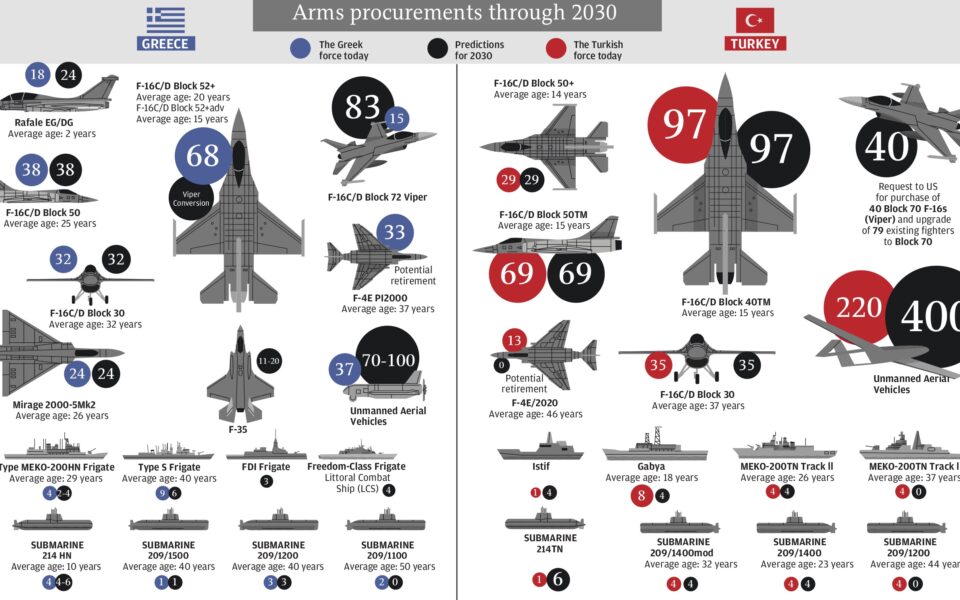Greece, Turkey: Power in the air and at sea
Examining what the balance of forces will look like in 2030, based on Athens’ already earmarked defense procurement program

US approval of the sale to Greece of up to 40 F-35 fighters as a counterweight to the procurement of F-16 aircraft and upgrade kits to Turkey rekindles the debate about the balance of forces in the Aegean.
Kathimerini presents the Greek-Turkish balance of power in some crucial weapons systems – fighters, unmanned aerial vehicles (UAVs), frigates and submarines – as it currently stands and as it is projected to be in 2030, a year set by the Defense Ministry’s current civilian leadership as a milestone for achieving some medium-term goals for the Hellenic Armed Forces.
Fighters
The data we present allow us to discern certain specific trends. To begin with, it looks like the Hellenic Air Force is several steps ahead of Turkey’s (THK). Greece’s Air Force already has modern French-made Rafales and the modernization of 83 F-16s to the Viper configuration is proceeding at a satisfactory clip. And the first F-35 is expected to arrive, probably at Andravida Air Base, by 2030.
There are, however, some issues with the F-16 upgrade, as there is a compatibility problem between the electronic countermeasures systems and the radars, which, on paper, the systems’ builder and Hellenic Aerospace (EAV) have committed to resolving.
Today’s Turkish Air Force comprises almost exclusively F-16s (plus some old F-4E Phantoms) and it was keen to secure US approval for the acquisition of new aircraft and the upgrading of existing ones, as well as about 900 missiles. The approval will keep a sort of balance the US apparently wishes to maintain, with Greece being a step ahead in technology in air power.
Drones
As far as drones are concerned, the balance of power is reversed, with Turkey having a clear advantage over Greece. Turkey has managed to become a major exporter of drones, turning it into a major export advantage. Based on the claims of its representatives, Turkey’s defense industry’s exports reached €5.5 billion in 2023, with the lion’s share coming from drones and related systems. European countries such as Albania, Poland and Ukraine have bought drones, alongside non-European countries such as Azerbaijan, Bangladesh, Ethiopia, Libya, Pakistan, Saudi Arabia and Somalia, as well as almost all Central Asian post-Soviet republics.
Greece is moving very slowly in this sector. Recently, Defense Minister Nikos Dendias expressed the desire to boost production of drones as well as aircraft parts.
The bill restructuring EAV is expected to be introduced soon. The new management, with a new CEO and two key lieutenants will implement the restructuring.
The aging fleet
The situation is even more difficult in the Navy, where Greece enjoyed a quality advantage. The Hellenic Navy’s fleet keeps aging and the country’s shipbuilding capabilities are limited, or inadequately developed, according to some. The numbers clearly expose Greece’s problems: Of course, the country is expecting three French-built frigates, and, as a “bonus” to the acquisition of the F-35s, four littoral combat ships (LCSs) from US stock. The same program envisages Greek involvement in Italy’s construction of 20 Constellation-class multi-mission frigates for the US Navy. This class of ships will be acquired by very few countries. At the same time, Turkey has dramatically expanded its shipbuilding capabilities. Its navy has had delivered the first Istif-class frigate and its shipyards will deliver another three by 2030. The low cost, no more than €350 million per unit, is an additional advantage.
Under its MILGEM (“national ship”) building program, Turkey has already got several Ada-class corvettes, at a unit cost of €150 million. It becomes obvious that, as high as its needs may be, Greece cannot compete as far as the number of ships are concerned; cost is the decisive factor.
Currently, Greece is not investing in its domestic shipbuilding industry, and past inefficiencies persist, as the Navy, in some cases, pays for shipbuilding projects that are never implemented. At the operational level, Athens also has to deal with a significant exodus of naval staff, officers and others. The government hopes that with better salaries, which will boost not only the personnel’s income but also its morale, the situation will improve by 2030.
Submarines
Greece maintains an advantage underwater, with its German-made Type 214 submarines, and by 2030 an additional two will be on their way. Turkey follows closely behind, as it has already had its first Type 214 vessel delivered and it aims to build five more at the Istanbul shipyards by 2030. Type 214s are highly effective, something proven in 2020 when tensions between the two countries were heightened by the operations of Turkish research vessel Oruc Reis.
Finally, Turkey has an advantage in unmanned submarines and surface vessels, with two types currently under construction. Greece is making an effort to start building its own vessels in coming years.





